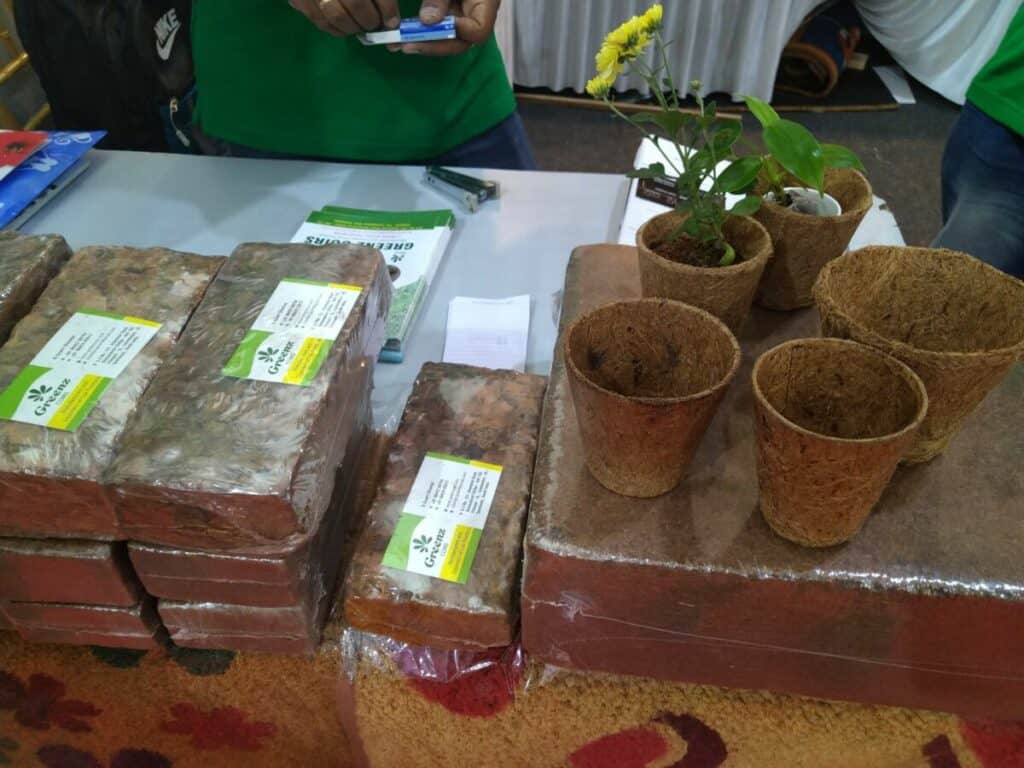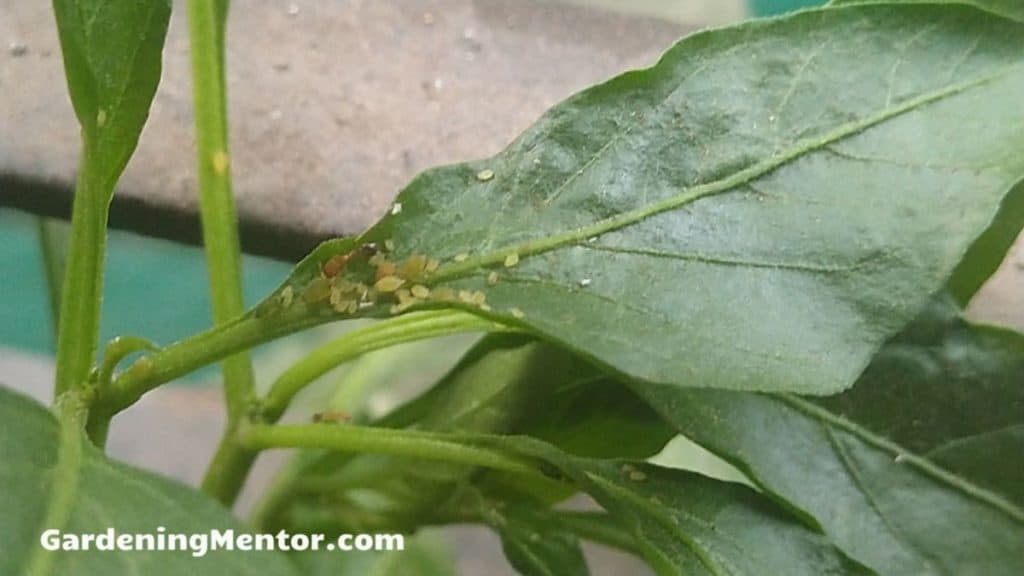Some of my friends suggested using diatomaceous earth in my potted plants to get rid of aphids. I was intrigued and researched more about this material and how to use it on my plants.
Sprinkle diatomaceous earth around the base of the plant to prevent pests. Sprinkle the powder on the leaves to get rid of existing pests. The other option is to mix the diatomaceous earth with water and then apply it on the leaves. This avoids blowing it all over yourself and the garden. Check out the best diatomaceous earth on Amazon.com.
What is diatomaceous earth?
Diatomaceous earth is the fossilized remains of tiny organisms called diatoms. You can find these remains in streams, rivers, and the ocean bed.
The main ingredient of diatomaceous earth is silica which is one of the hardest substances on earth. You can find this also in materials like glass and concrete. You need to use food-grade diatomaceous earth for plants that is harmless to humans and animals.
The main benefit of using diatomaceous earth in your potting soil is to get rid of harmful insects. It is beneficial against insects with an exoskeleton like aphids, pillbugs, mites, thrips, beetles, snails, and slugs.
The diatomaceous earth you buy looks like a fine, white powder but it has small modules with sharp edges. These sharp edges cut through the exoskeleton of the bugs and drain out the water and fat.
The diatomaceous earth causes the insects to dehydrate and die in a few days after the application of the material to your potting soil.
The other benefit of using diatomaceous earth for plants is as an amendment to the potting soil. This material provides moisture-retaining texture to the potting soil. It retains sufficient moisture while draining out the excess.
If you’re looking to amend the potting soil, I would also recommend adding peat moss or coco coir to improve the texture.

The diatomaceous earth for plants releases the moisture slowly when the soil dries out. So you don’t need to water the potting soil as often.
The diatomaceous earth also helps the plant develop a healthy root system and assists in the absorption of nutrients from fertilizer.
Once you apply the material to your potting soil and plant, it can last till the time you water the soil or rain washes it away.
How to use diatomaceous earth in potted plants?
You can use diatomaceous earth in the potting plants when you find they are infested with pests. The diatomaceous earth is most effective against soft-bodied insects.
The best time to apply diatomaceous earth is in the morning after the dew has settled. Or the time just after a light rain.
If you apply diatomaceous earth to the potting soil and it rains, it will get washed away and you need to reapply it.
Diatomaceous earth is a dry, powder so you need to protect yourself from the dust. You need to wear a mask and protection goggles for safety.
Keep your children and pets away from the area till you spray the diatomaceous earth on your plants and the dust settles.
Make sure to spread the powder only when the conditions are non-windy. This will help you spray the powder on the plants rather than all over the garden.
You can use any dust spreader to spray the diatomaceous earth on your potting soil. I would suggest to also spray the powder on the foliage to get rid of the insects. Spray the dust on both the outer and inner sides of the leaves.
You want to make sure that all the foliage and the soil is covered with the dust. Otherwise, the insects will avoid the material and find another way to reach your plants.
You can also apply the diatomaceous earth after mixing it with water. This will help prevent the dust from spreading all over your garden.
You can mix 2 cups of diatomaceous earth with 1 gallon of water and then spray it on your plants and potting soil. The dust will stick to the plants and will be effective when the material dries out.
How to use diatomaceous earth in potting soil?
You can also add diatomaceous earth to the potting soil when preparing the container for growing a plant.
You need to mix about 10-15% diatomaceous earth to the potting soil when using an outdoor pot. You can use 15-20% diatomaceous earth when growing in a hanging basket.
The diatomaceous earth has a texture that retains moisture while draining out the excess. It also provides good aeration to the plant’s roots.
The diatomaceous earth provides a rich source of silica to the plant. This helps improve the health and vitality of the plant.
If you add fertilizer to the potting soil that contains diatomaceous earth, the plant’s roots are shown to absorb the nutrients at a better rate.
How often should you apply diatomaceous earth?
When using diatomaceous earth for pest control, it’s best to apply after a light rain or in the morning after the soil had dried. You need to apply diatomaceous earth once and it will take effect killing the pests.
But if it rains, the powder will get washed away from the plants and fall into the soil. So you’ll need to reapply it again.
You can apply diatomaceous earth to the plants whenever you find insects have infested the plant. It does not cause any harm to your potted plants.
If you have a full-blown infestation of pests it’s best to apply diatomaceous earth every week for at least a month. This will give it the best chance for it to affect adults as well as nymphs of the insects.
When using diatomaceous earth in your potting soil, it’s best to apply before watering the plant. This helps the material absorb into the soil and provide the required nutrients to it.
I would suggest applying the diatomaceous earth every month as part of your cycle where you add a slow-release fertilizer to the potting soil. The diatomaceous earth will improve the absorption of the nutrients by the potting soil.
Where can you buy diatomaceous earth?
You can buy diatomaceous earth at your local garden center or Home Depot. You can also find it online at Amazon and Walmart.
Make sure to buy food-grade diatomaceous earth as this is the non-toxic variety you need for your potted plants.
I recommend the Diatomaceous Earth Powder you can find on Amazon that is pure, 100% organic, and safe for children and pets.
Here is a list of diatomaceous earth you can buy online.
- Diatomaceous Earth Powder
- HARRIS Diatomaceous Earth
- Safer Diatomaceous Earth
- EasyGoProducts Diatomaceous Earth
- Earthborn Elements Diatomaceous Earth
How long does diatomaceous earth take to kill bugs?
Diatomaceous earth can take from hours to days to kill bugs. This depends on the type of bugs and the severity of the infestation.
If you find a full-blow infestation of bugs on your plant, it’s best to apply the diatomaceous earth every week for at least a month.
This gives it the best chance to attack both the adult and nymph stages of the bugs as the new eggs hatch.
Diatomaceous earth only works when it’s dry so any rain or water on the plants will reduce its impact. You need to reapply the material after the rain has stopped so it can continue killing the bugs.
| Bug | How long does DE take to kill? |
| Beetles | 7-21 days |
| Silverfish | 7-14 days |
| Black ants | 24 hours |
| Red ants | 16 hours |
| Earwigs | 48 hours |
| Mites | 5-10 days |
| Gnats | 10-21 days |
| Aphids | 5-10 days |
| Springtails | 7-14 days |
Will diatomaceous earth kill beneficial insects?
The diatomaceous earth you want to use has to be food-grade. This makes it harmless for humans and animals but harmful to insects.
Diatomaceous earth powder has the sharp microscopic edges that cut through the exoskeleton of insects. This causes them to dehydrate and die.
So the diatomaceous earth will kill both harmful and beneficial insects with exoskeletons that come in contact with it.
It will also affect bees that get covered with the material when reaching for pollen in the flowers.
Earthworms don’t have an exoskeleton but are covered by a layer of mucous that helps them slide on the soil. So diatomaceous earth is not found to be harmful to them.
I would recommend you add earthworms such as red wigglers to the soil because they will improve the texture and provide nutrients.
I would suggest to only use diatomaceous earth when there is a big insect infestation on your potted plants.
You should cover up the plant after using the material so that beneficial insects like bees and lacewings don’t get harmed by it.
Does diatomaceous earth lose its potency?
Diatomaceous earth is the mineral deposited by the fossilization of diatoms found in rivers, streams, and the ocean. So it can remain potent for a very long period of time.
You do need to store it in a cool, dry place so it remains effective when you want to use it. The best place to store it is in an air-tight container. You could also store it in the refrigerator but keep it away from food as it can take on scents of leftovers.
What are the benefits of using diatomaceous earth in your potted plants?
It helps control pests
The most common reason to use diatomaceous earth is that it kills pests in your potted plants. You can get rid of several insects like aphids, whiteflies, beetles, silverfish, earwigs, gnats, and ants using it.

It helps improve the potting soil
The diatomaceous earth when mixed with potting soil helps improve its texture. The material has moisture-retention abilities so it keeps sufficient moisture in the soil while draining out the excess.
When the soil becomes dry, the diatomaceous earth releases the absorbed moisture back into the soil. This helps reduce the frequency of having to water the potted plants.
The diatomaceous earth for houseplants helps the plant roots to absorb nutrients from the soil as well as the fertilizer you add to the potting soil.
It helps deodorize your plants
Potted plants may develop an odor because of moss, fungi, or bacteria growing in them. Spraying some diatomaceous earth on them will help reduce such odor.
If your pets make use of your potting soil as a toilet, a spray of diatomaceous earth will help remove the odor and discourage your pets from doing so.

Fact Checked, Written, and Published by Kevin Rodrigues
Kevin is the founder of Gardening Mentor, a website that aims to teach people to grow their own food in a limited space. As a self-taught gardener, Kevin has spent several years growing plants and creating gardening content on the website. He is certified in Home Horticulture and Organic Gardening from Oregon State University. He has a Post Graduate Diploma in Horticulture and Landscape Gardening from Mumbai University.
Read more
